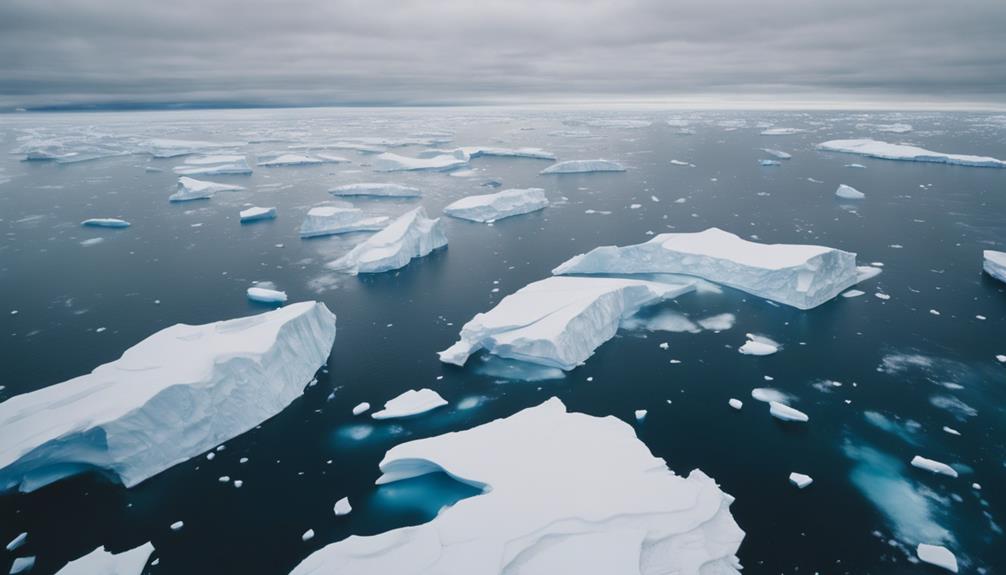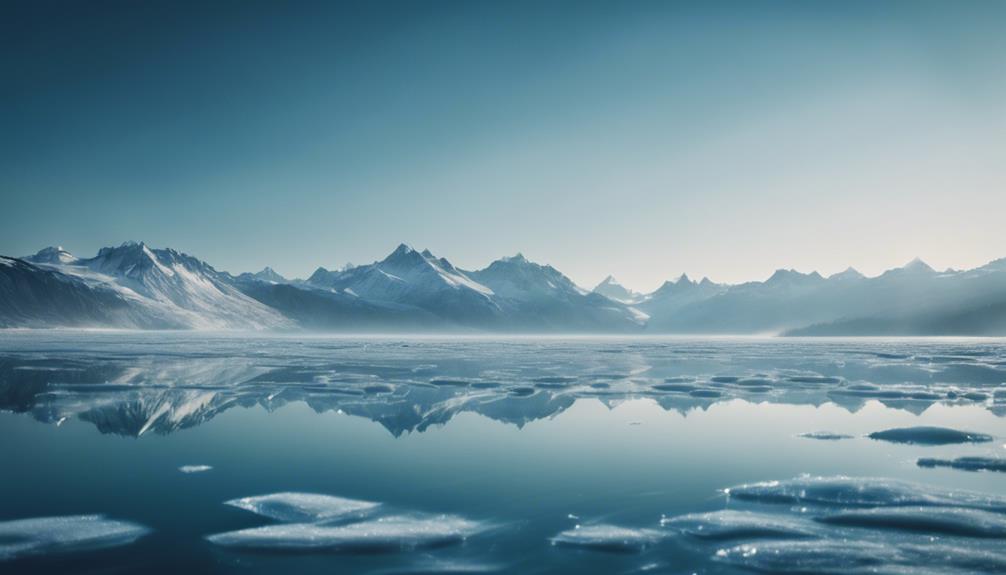You won't believe that the coldest place on Earth is the East Antarctic Plateau. Here, temperatures have plummeted to an astonishing -136°F (-93.2°C) and may even reach -144°F (-98°C), according to recent satellite data. This desolate region's extreme chill comes from high elevation, clear skies, and long polar nights, which enhance heat loss. The icy wasteland is so frigid that it shapes life in unique ways, drawing scientific interest and research initiatives. Curious about the incredible discoveries made there? You'll find out more about this chilling place and its mysteries in the following sections.
Background Information
You might be surprised to learn that the coldest place on Earth has a fascinating background.
It's not just about the world's lowest recorded temperature; it also involves the unique climate that shapes life in such an extreme environment.
Plus, previous research expeditions have uncovered significant insights into this icy region.
Born in a Cold Climate
Life in extremely cold climates, like the East Antarctic Plateau, often faces unique challenges and adaptations due to the harsh environmental conditions.
In this part of East Antarctica, you encounter some of the planet's coldest temperatures, with readings plummeting to -136°F (-93.2°C). Such extreme temperatures create an inhospitable environment for most forms of life. Long, sunless winters and relentless frigid winds dominate the landscape, making survival difficult.
Microbial life is sparse, with only about 10^3 cells/ml of snowmelt found, illustrating how challenging it is for organisms to thrive in these conditions. The plateau's high elevation and extensive ice coverage further exacerbate the harshness of the climate.
Researchers studying this region focus on understanding how life adapts to such extreme environments and how these conditions relate to broader climate change issues. The East Antarctic Plateau serves as a vital site for learning about resilience in the face of colder temperatures and environmental stressors.
This knowledge helps scientists predict possible future changes in our global climate, emphasizing the importance of studying areas like this one.
World's Lowest Recorded Temperature
The East Antarctic Plateau not only showcases extreme adaptations to cold but is also home to the world's lowest recorded temperature, a staggering -128.6°F (-89.2°C) documented at Vostok Station in 1983. This record highlights the harsh conditions of the Antarctic, where the East Antarctic Ice Sheet reigns supreme in delivering some of the coldest temperatures on Earth.
Satellite data analysis suggests that temperatures in this region can plummet even lower, reaching -144°F (-98°C) in certain areas. Places like Dome Argus, which sits at a high elevation, consistently experience extreme cold, with recent readings dipping below -136°F (-93.2°C).
The climate here is characterized by prolonged polar nights, which play a vital role in maintaining these frigid conditions. Clear skies and dry air greatly contribute to heat loss from the surface, allowing the cold to set in even deeper.
In this unforgiving environment, the coldest temperatures challenge life as it's understood, making the East Antarctic Plateau a true reflection of the extremes of our planet.
Previous Antarctic Research Expeditions
During the early 20th century, pioneering expeditions to Antarctica revealed the vast mysteries of the East Antarctic Plateau, setting the stage for future research in this extreme environment. The first sighting of this remarkable region occurred during the Discovery Expedition led by Robert Falcon Scott in 1903.
Then, Ernest Shackleton crossed parts of the plateau in 1909, coming within 97 nautical miles of the South Pole during his Nimrod Expedition. Shackleton initially named the plateau King Edward VII Plateau, but Roald Amundsen later renamed it King Haakon VII Plateau in December 1911, honoring Norway's newly elected king.
Another significant milestone in Antarctic exploration took place in 1929 when Bernt Balchen piloted a Ford Trimotor for the first aerial observation of the plateau, organized by Richard E. Byrd.
These early expeditions not only documented the region's harsh conditions but also laid the groundwork for understanding Antarctica's unique climate and geography. They set a previous record held for human endurance in one of the most inhospitable places on Earth, inspiring generations of researchers to follow in their footsteps.
Current Updates or Main Focus

You might be interested to know about the latest Antarctic research initiatives that are pushing the boundaries of our understanding of extreme cold.
New scientific collaborations are emerging, bringing together experts to tackle pressing climate questions.
Innovative climate research projects are also underway, focusing on how these frigid environments respond to global changes.
New Antarctic Research Initiatives
Recent Antarctic research initiatives are uncovering how polar microorganisms thrive in extreme cold while playing a significant role in snowpack ecology. These studies focus on the coldest temperatures recorded in East Antarctica, where scientists are examining the adaptability of microbial life. As climate change continues to impact this fragile ecosystem, understanding these microorganisms becomes essential for predicting future environmental shifts.
Researchers are investigating how temperature fluctuations affect the snowpack and the organisms within it. By analyzing ice core samples from research stations like Vostok and Amundsen-Scott, scientists gain valuable insights into the region's climatic history and current conditions. This research highlights the importance of polar microorganisms in maintaining ecological balance, especially in the face of climate change.
Moreover, ongoing studies assess the unique climatic conditions of Antarctica, revealing potential impacts on global weather patterns. The findings not only enhance our knowledge of this remote environment but also emphasize the need for further investigation into how these ecosystems respond to ongoing changes.
New Scientific Collaboration Projects
Scientific collaboration projects in Antarctica are actively uncovering the complexities of microbial ecology and how these organisms adapt to extreme conditions while responding to climate change. Researchers are diving into the role of polar microorganisms in snowpack ecology, revealing their resilience in some of the coldest temperatures on Earth. This ongoing work sheds light on how these tiny life forms thrive despite the harsh environment.
Current initiatives focus on understanding the impact of climate change on polar ecosystems. International teams are collecting and analyzing data to grasp the environmental shifts affecting biodiversity in Antarctica. Through these collaborative efforts, scientists are also exploring the geological history of the region, with fossil discoveries shedding light on prehistoric marine life and climate shifts.
Moreover, researchers are leveraging advanced satellite technology to monitor temperature extremes and ice dynamics. This critical data helps inform climate modeling and environmental assessments, ultimately contributing to our understanding of how Antarctica influences global weather patterns. By piecing together these intricate details, you're witnessing a significant leap in knowledge that could shape future climate strategies.
Innovative Climate Research Projects
Innovative climate research projects in Antarctica are pushing the boundaries of our understanding of how extreme environments respond to ongoing climate change. Scientists are delving into the role of polar microorganisms, revealing their adaptations to the coldest temperatures on Earth. These microorganisms are vital for snowpack ecology, influencing nutrient cycling and ecosystem health.
At Vostok Station, researchers analyze ice cores, uncovering information about past climate conditions and the unique ecosystem of Lake Vostok, which lies beneath the ice. Meanwhile, studies at the East Antarctic Plateau focus on the impacts of climate change, particularly temperature fluctuations, and their ecological consequences. This research is essential for predicting how these cold regions will respond to a warming planet.
International collaboration enhances the understanding of Antarctica's unique climatic conditions, especially the effects of prolonged darkness during polar winters. Additionally, current investigations into prehistoric marine fossils shed light on the historical biodiversity of Antarctica, offering insights into climate evolution and the region's geological history.
Together, these innovative projects are vital for grasping the broader implications of climate change in one of the most extreme environments on Earth.
Detailed Analysis

As you explore the recent Antarctic temperature measurements, you'll notice how they've reshaped our understanding of extreme cold.
Media coverage has amplified public perception, making these chilling discoveries more accessible than ever.
Researchers also weigh in, highlighting the significance of these temperature extremes in the context of climate change.
Recent Antarctic Temperature Measurements
Recent measurements reveal an astonishing new record for the coldest temperature on Earth, hitting -144°F (-98°C) in the East Antarctic Plateau. This groundbreaking finding surpasses the previous record of -135°F (-93°C), showcasing a significant drop in temperature. The extreme cold in this region can be attributed to a combination of clear skies, dry air, and the high elevation of the plateau.
Researchers utilized reexamined satellite images over the Antarctic Ice Sheet to capture these coldest temperatures accurately. This advancement in monitoring techniques enhances our understanding of climatic extremes in Antarctica and their broader implications. The East Antarctic Plateau has emerged as a prime location for studying these severe conditions, providing essential data that could inform climate models and predictions.
As you learn about these temperature extremes, you might appreciate how they influence global climate patterns. The findings reiterate the importance of ongoing research in this frigid part of the world. Each measurement taken here helps paint a clearer picture of our planet's changing climate, making it imperative to keep an eye on the East Antarctic Plateau and its chilling records.
Media Coverage and Public Perception
Media coverage of the coldest places on Earth captivates audiences, illustrating both the extreme conditions and the scientific endeavors undertaken in these icy domains. When you read about the East Antarctic Plateau or Vostok Station, you're drawn into a world that challenges human endurance. Reports often highlight record-breaking temperatures, like the staggering -136°F, emphasizing not just the chill but the urgent narratives surrounding climate change.
These stories shape public perception, painting a vivid picture of how climate variability starkly contrasts with average global temperatures. The dramatic visuals and tales of exploration evoke a sense of wonder and concern, making these regions seem like the ultimate frontiers of both extreme weather and scientific discovery. You might feel a mix of fascination and urgency as you consider the impacts of climate change on these frozen landscapes.
Moreover, the ongoing research and unique adaptations of life in such harsh conditions remind you of the resilience of nature and humanity's quest for knowledge. Media coverage plays an essential role in highlighting these aspects, driving home the importance of understanding our planet's extremes and the pressing challenges we face.
Researcher Comments on Temperature Extremes
Researchers frequently emphasize that the East Antarctic Plateau's record low temperatures reveal significant insights into our planet's climate dynamics. Recent findings show temperatures plummeting to an astonishing -144°F (-98°C) near Dome Argus, establishing it as the coldest place on Earth. This drastic drop from the previous record of -135°F (-93°C) highlights the plateau's unique environment, shaped by high elevation, clear skies, and dry air.
Polar geophysicists are particularly interested in these extremes, as they help us understand the broader implications for climate change. The conditions that foster such cold temperatures are essential for studying how ecosystems adapt in these harsh environments. Near-surface air temperature measurements taken at about 6 feet (2 meters) are crucial for accurately evaluating these extremes and their impact on polar microorganisms, which play a critical role in snowpack ecology.
Understanding the East Antarctic Plateau's coldest temperatures isn't just about record-breaking statistics; it's about uncovering the intricate relationships between climate systems and the ecosystems that depend on them. This research can inform our response to ongoing climate challenges, emphasizing the need for continued exploration and understanding of these extreme environments.
Public Reaction or Expert Opinions

You've probably seen viral memes about freezing temperatures that spark laughter and disbelief.
Social media buzzes with reactions to the extreme cold, while researchers share insights on cold trends and their significance.
Understanding these perspectives can deepen your appreciation for the harsh realities of our planet's climate.
Viral Memes About Freezing Temperatures
How do viral memes about freezing temperatures capture the absurdity of life in the cold? These clever creations often highlight just how extreme the coldest temperatures can be, especially when you compare them to more familiar locations.
For example, memes might depict the shock of stepping outside in Yakutsk or Oymyakon, where daily life often seems like a warm vacation compared to the staggering lows recorded in Antarctica, hitting -144°F.
You'll find that these memes resonate with your everyday struggles, like trying to get out of bed when it's freezing or dealing with stubbornly frozen car doors. They cleverly exaggerate the challenges of cold weather, turning mundane experiences into relatable laughter.
Expert opinions suggest that the unique climatic conditions of Antarctica fuel this meme culture, turning polar freezes into comedic gold.
In a world where winter makes everything a little more difficult, these memes serve as a humorous reminder that we're all in this together, sharing the ridiculousness of surviving freezing temperatures. They not only entertain but also highlight our shared human experience in the face of nature's coldest extremes.
Social Media Buzz and Reactions
Social media has exploded with reactions to the astonishing temperatures recorded at the East Antarctic Plateau, with users expressing a mix of disbelief and fascination. Many are shocked to learn that this region holds the title of the coldest place on Earth, where temperatures can plummet to an incredible -144°F (-98°C). Posts flood platforms like Twitter and Instagram, showcasing memes and facts that highlight the extreme climate conditions.
You'll find conversations ranging from humorous takes on how to survive such cold to serious discussions about climate change. Some users have even taken the opportunity to educate others about the scientific reasons behind these chilling temperatures, such as the area's high elevation, clear skies, and dry air.
The buzz also emphasizes the broader implications of such extreme conditions for climate research. People are curious about how life, including microorganisms, thrives in these frigid environments.
Researcher Insights on Cold Trends
Researchers are increasingly concerned about the implications of rising temperatures in Antarctica, as their studies reveal unsettling trends that could reshape our understanding of global climate dynamics.
The coldest recorded temperature on Earth, a staggering -144°F (-98°C), was found on the East Antarctic Plateau, showcasing the region's extreme climate conditions. Experts point out that the unique combination of high elevation, clear skies, and dry air plays a significant role in these record low temperatures.
Prolonged periods of darkness during the polar winter further enhance cooling effects, enabling extreme temperature drops. However, ongoing studies highlight how climate change is affecting these cold regions.
Shifts in temperature patterns are being observed, and researchers fear that these changes could disrupt global climate systems. Satellite images and ground measurements are continually refining our understanding of temperature distribution and cold trends across Antarctica.
As you consider these findings, it's crucial to grasp that the implications of climate change extend even to the coldest places on Earth, such as the East Antarctic Plateau, where a delicate balance is now at risk.
Broader Implications

As you explore the implications of the East Antarctic Plateau's extreme conditions, you'll see how it drives climate research funding and spurs breakthroughs in understanding freezing temperatures.
This research not only uncovers essential data about ice dynamics but also shapes future scientific endeavors in the region.
Ultimately, these findings can greatly influence global climate policies and our approach to emerging environmental challenges.
Impact on Climate Research Funding
Increased funding for climate research in extreme cold regions highlights their essential role in shaping our understanding of global climate change and its far-reaching effects. The coldest places on Earth, like Antarctica, have revealed record-low temperatures that have ever been recorded, reaching a staggering -144°F (-98°C). This revelation has sparked a surge in interest among scientists and funding agencies alike.
As you explore climate studies, you'll notice that collaborative international efforts in these frigid environments have led to significant data collection. Such data not only enhances climate models but also influences funding priorities for future research endeavors. The harsh conditions and unique ecosystems necessitate specialized equipment and methodologies, which often come with a hefty price tag.
Ongoing studies in these polar regions, bolstered by increased funding, are essential for monitoring climate change effects. You'll see this in the glacial melt and shifts in microbial ecosystems that hold implications for global environmental policies. By investing in cold climate research, we can better understand the overarching impacts of climate change and work towards effective solutions.
Emerging Antarctic Ice Research
Emerging studies on Antarctic ice are revealing essential insights into how climate change is reshaping our planet's ecosystems and weather patterns. Recent research on the East Antarctic Plateau highlights chilling temperatures, dropping as low as -144°F (-98°C), demonstrating the extreme cold of this region.
As scientists investigate the Antarctic ice sheet, they uncover the potential consequences of melting ice, including rising sea levels that could threaten coastal communities worldwide.
These studies also focus on polar microorganisms, which thrive in harsh conditions, helping us understand how life adapts to extreme cold. The resilience of these tiny organisms provides clues about ecosystem dynamics and the broader implications of climate change. By examining microbial communities, researchers are gaining valuable insights into their environmental adaptations and their role in climate processes.
Collaborative international efforts in this unforgiving landscape face challenges, from prolonged darkness during polar winters to the need for specialized equipment. However, the knowledge gained from these studies is vital for predicting future climatic shifts and understanding the interconnectedness of our planet's systems.
As research progresses, we will see how Antarctic ice research can inform global responses to climate change, making it a focal point for environmental science.
Scientific Breakthroughs in Freezing Temperatures
Recent scientific breakthroughs in freezing temperatures have revealed essential insights into how life can endure in some of the harshest environments on Earth. The East Antarctic Plateau, known as the coldest permanently inhabited place, recently recorded a staggering temperature of -144°F (-98°C). This extreme cold isn't just a record; it offers researchers a unique opportunity to study how certain microbes, like Alphaproteobacteria and Cyanobacteria, adapt to such conditions.
These resilient species provide clues about life's capabilities in extremes, which can influence our understanding of climate change. The harsh environment challenges researchers to employ advanced measurement techniques to obtain accurate temperature readings, highlighting both the difficulties and significance of conducting research in these conditions.
Moreover, ongoing investigations into the geological history of Antarctica, including fossil discoveries, help reconstruct past ecosystems and climate conditions. This knowledge is crucial for refining current climate models, as it underscores how life can thrive under seemingly impossible circumstances.
Frequently Asked Questions
Which Is the No. 1 Coldest Place in the World?
You might find that the coldest place in the world is the East Antarctic Plateau. It's recorded temperatures plummet to -144°F, showcasing extreme cold due to its high elevation, clear skies, and dry conditions.
What Is the Absolute Coldest Place on Earth?
The absolute coldest place on Earth is the East Antarctic Plateau, where temperatures drop as low as -144°F. Its unique geography, clear skies, and extended winter darkness contribute to these extreme conditions.
What Is the Coldest Place on Earth Right Now?
Right now, the coldest place on Earth is the East Antarctic Plateau. With temperatures plummeting to -144°F, it showcases extreme conditions caused by high elevation, dry air, and clear skies. It's truly astonishing!
Where Is the Coldest Recorded Place on Earth?
The coldest recorded place on Earth is the East Antarctic Plateau. Here, satellite data revealed jaw-dropping temperatures of -144°F. This extreme cold results from high elevation and dry air conditions unique to the area.
Did You Know the Coldest Place on Earth Is Near Which Ocean?
The coldest place on Earth is near the Southern Ocean. Antarctica, the frozen continent, is home to the lowest temperature ever recorded, which was a bone-chilling -128.6 degrees Fahrenheit. These fascinating facts about 5 oceans highlight the extreme conditions at the bottom of the world.
Conclusion
So, there you have it—the coldest place on Earth may surprise you!
With extreme temperatures and unique conditions, it's a reminder of our planet's incredible diversity.
Whether you're planning a visit or just curious, understanding these extremes can spark a deeper appreciation for nature.
As we learn more about these frigid regions, let's keep fostering curiosity and respect for our environment.
After all, who knows what other wonders are waiting to be discovered!










